|
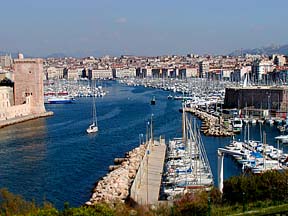 Provence is an area in southeastern France and includes the cities of Marseilles, Avignon, Arles, Aix-en-Provence, Nimes, etc. It extends from Nimes in the west to Monoco in the east, Orange to the north and the Mediterranean to the south. We visited this area the first time in 1997 with Verna’s folks, then again briefly in 2001 when we attended the Touratech event in Orange, and once again in late March, 2002, then later in September of the same year. As you can tell, we do enjoy the area. It is an area of gentle climate, lots of agriculture (olives, lavender, and fruit orchards), and a rich history of the Roman era. Provence is an area in southeastern France and includes the cities of Marseilles, Avignon, Arles, Aix-en-Provence, Nimes, etc. It extends from Nimes in the west to Monoco in the east, Orange to the north and the Mediterranean to the south. We visited this area the first time in 1997 with Verna’s folks, then again briefly in 2001 when we attended the Touratech event in Orange, and once again in late March, 2002, then later in September of the same year. As you can tell, we do enjoy the area. It is an area of gentle climate, lots of agriculture (olives, lavender, and fruit orchards), and a rich history of the Roman era.
Marseilles is probably the most well-known city in the area, but a bit large for our tastes. However, it is worth a visit, especially the port area which is teeming with sailing vessels and still supports a lively fishing industry. There are actually 2 ports of Marseilles, the old port where you will find the many marinas, restaurants, and seaside commerce. Nearby is a pedestrianized shopping district as well as notable historic buildings such as the opera house, the Fort St. Nicholas, Palace of the Pharo, etc. Above right is a photo of the ol d port, flanked by the old protective battlements. Below left is a view of the Fort St. Nicholas, built in the mid-1600s by Louis XIV to assert his power over the defiant city. Evidently Marseilles has shown its independent streak throughout history; for a brief time in the 13th century, it was itself a republic. It was absorbed into France in 1481, but did not submit to the crown until 1660. The fort’s size and location at the mouth of the port ensured control over the city, although that didn’t stop the citizens from trying to demolish the fort in the late 1700s. d port, flanked by the old protective battlements. Below left is a view of the Fort St. Nicholas, built in the mid-1600s by Louis XIV to assert his power over the defiant city. Evidently Marseilles has shown its independent streak throughout history; for a brief time in the 13th century, it was itself a republic. It was absorbed into France in 1481, but did not submit to the crown until 1660. The fort’s size and location at the mouth of the port ensured control over the city, although that didn’t stop the citizens from trying to demolish the fort in the late 1700s.
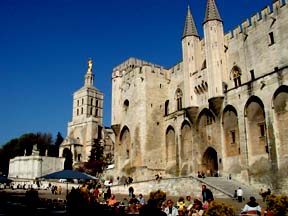 Avignon is another interesting city in Provence, a little more to our liking. The old walled city is still pretty much intact and is of most interest to visitors. Much of Avignon’s fame comes from the fact that in the 14th century Pope Clement V and his court established themselves here, trying to avoid the political turmoil in Rome at the time. The Palace of the Pope remains as a main visitor site (picture at right). Avignon is another interesting city in Provence, a little more to our liking. The old walled city is still pretty much intact and is of most interest to visitors. Much of Avignon’s fame comes from the fact that in the 14th century Pope Clement V and his court established themselves here, trying to avoid the political turmoil in Rome at the time. The Palace of the Pope remains as a main visitor site (picture at right).
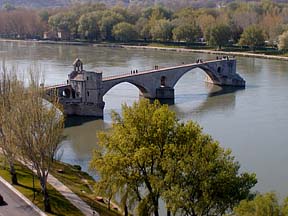 Just to the northwest of the palace is the Pont St. Benezet, which many will know as the Pont d’Avignon from the famous French nursery rhyme (Verna learned this rhyme in her high school French class, but Jim has no idea what she is talking about). The bridge was originally constructed in the 12th century to link Avignon and Villeneuve-les-Avignon. Although the bridge no longer fully spans the Avignon River (it lost 4 of its spans in the 17th century), it remains an attractive site (left). For 3 Euro you can walk out to the end of the bridge. Just to the northwest of the palace is the Pont St. Benezet, which many will know as the Pont d’Avignon from the famous French nursery rhyme (Verna learned this rhyme in her high school French class, but Jim has no idea what she is talking about). The bridge was originally constructed in the 12th century to link Avignon and Villeneuve-les-Avignon. Although the bridge no longer fully spans the Avignon River (it lost 4 of its spans in the 17th century), it remains an attractive site (left). For 3 Euro you can walk out to the end of the bridge.
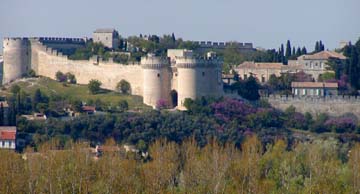 Just north of the Palace of Popes is a lovely tranquil park used by the locals. This park is a great place for a quiet stroll or a view over the Avignon River. From here, there are good views to Villeneuve-les-Avignon and the Fort St. Andre built between 1364 and 1368 (pictured at right). Just north of the Palace of Popes is a lovely tranquil park used by the locals. This park is a great place for a quiet stroll or a view over the Avignon River. From here, there are good views to Villeneuve-les-Avignon and the Fort St. Andre built between 1364 and 1368 (pictured at right).
Our favorite pastime in Avignon is simply wandering the old streets, viewing the shops, and enjoying a leisurely lunch at one of the many outdoor cafes. On a warm spring day, it doesn’t get much better than that!
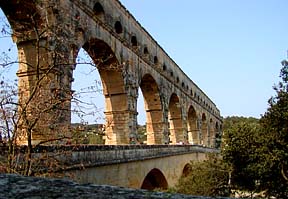 A nearby Roman ruin is that of Pont du Gard (the bridge over the river Gard; picture at left). The lower part of the bridge (just above the arches on the bottom) served to carry people and carts across the river, while at the very top (above the highest row of arches) an enclosed aqueduct carried fresh water to the cities. We originally visited this site in 1997; at the time there was a small car park on either side of the river with a couple of open air shops managed by local entrepreneurs A nearby Roman ruin is that of Pont du Gard (the bridge over the river Gard; picture at left). The lower part of the bridge (just above the arches on the bottom) served to carry people and carts across the river, while at the very top (above the highest row of arches) an enclosed aqueduct carried fresh water to the cities. We originally visited this site in 1997; at the time there was a small car park on either side of the river with a couple of open air shops managed by local entrepreneurs 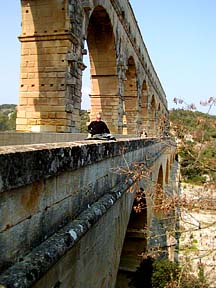 and dirt paths that took you to the bridge (although you could only get on it from one side). We were greeted this time by a huge new visitor center (one on each side of the river; complete with interpretation center, cafes and gift shops). The parking lot is greatly expanded, leveled, and costly! Luckily for us, bikes don’t pay for parking. This isn’t advertised, but one of the workers actually chased us down in the parking lot and showed us where we should park, then tore up our parking ticket! How’s that for service? You now walk out to the bridge on a paved pathway and you can access the bridge from either side of the river. Isn’t progress wonderful? Somehow, we kind of liked it better when it was a bit more primitive. At right, Jim is standing on the roadway portion of the bridge, so you can see how large the arches are. and dirt paths that took you to the bridge (although you could only get on it from one side). We were greeted this time by a huge new visitor center (one on each side of the river; complete with interpretation center, cafes and gift shops). The parking lot is greatly expanded, leveled, and costly! Luckily for us, bikes don’t pay for parking. This isn’t advertised, but one of the workers actually chased us down in the parking lot and showed us where we should park, then tore up our parking ticket! How’s that for service? You now walk out to the bridge on a paved pathway and you can access the bridge from either side of the river. Isn’t progress wonderful? Somehow, we kind of liked it better when it was a bit more primitive. At right, Jim is standing on the roadway portion of the bridge, so you can see how large the arches are.
|

 Provence is an area in southeastern France and includes the cities of Marseilles, Avignon, Arles, Aix-en-Provence, Nimes, etc. It extends from Nimes in the west to Monoco in the east, Orange to the north and the Mediterranean to the south. We visited this area the first time in 1997 with Verna’s folks, then again briefly in 2001 when we attended the Touratech event in Orange, and once again in late March, 2002, then later in September of the same year. As you can tell, we do enjoy the area. It is an area of gentle climate, lots of agriculture (olives, lavender, and fruit orchards), and a rich history of the Roman era.
Provence is an area in southeastern France and includes the cities of Marseilles, Avignon, Arles, Aix-en-Provence, Nimes, etc. It extends from Nimes in the west to Monoco in the east, Orange to the north and the Mediterranean to the south. We visited this area the first time in 1997 with Verna’s folks, then again briefly in 2001 when we attended the Touratech event in Orange, and once again in late March, 2002, then later in September of the same year. As you can tell, we do enjoy the area. It is an area of gentle climate, lots of agriculture (olives, lavender, and fruit orchards), and a rich history of the Roman era.  d port, flanked by the old protective battlements. Below left is a view of the Fort St. Nicholas, built in the mid-1600s by Louis XIV to assert his power over the defiant city. Evidently Marseilles has shown its independent streak throughout history; for a brief time in the 13th century, it was itself a republic. It was absorbed into France in 1481, but did not submit to the crown until 1660. The fort’s size and location at the mouth of the port ensured control over the city, although that didn’t stop the citizens from trying to demolish the fort in the late 1700s.
d port, flanked by the old protective battlements. Below left is a view of the Fort St. Nicholas, built in the mid-1600s by Louis XIV to assert his power over the defiant city. Evidently Marseilles has shown its independent streak throughout history; for a brief time in the 13th century, it was itself a republic. It was absorbed into France in 1481, but did not submit to the crown until 1660. The fort’s size and location at the mouth of the port ensured control over the city, although that didn’t stop the citizens from trying to demolish the fort in the late 1700s.  A
A Just to the northwest of the palace is the Pont St. Benezet, which many will know as the Pont d’Avignon from the famous French nursery rhyme (Verna learned this rhyme in her high school French class, but Jim has no idea what she is talking about). The bridge was originally constructed in the 12th century to link Avignon and Villeneuve-les-Avignon. Although the bridge no longer fully spans the Avignon River (it lost 4 of its spans in the 17th century), it remains an attractive site (left). For 3 Euro you can walk out to the end of the bridge.
Just to the northwest of the palace is the Pont St. Benezet, which many will know as the Pont d’Avignon from the famous French nursery rhyme (Verna learned this rhyme in her high school French class, but Jim has no idea what she is talking about). The bridge was originally constructed in the 12th century to link Avignon and Villeneuve-les-Avignon. Although the bridge no longer fully spans the Avignon River (it lost 4 of its spans in the 17th century), it remains an attractive site (left). For 3 Euro you can walk out to the end of the bridge. Just north of the Palace of Popes is a lovely tranquil park used by the locals. This park is a great place for a quiet stroll or a view over the Avignon River. From here, there are good views to Villeneuve-les-Avignon and the Fort St. Andre built between 1364 and 1368 (pictured at right).
Just north of the Palace of Popes is a lovely tranquil park used by the locals. This park is a great place for a quiet stroll or a view over the Avignon River. From here, there are good views to Villeneuve-les-Avignon and the Fort St. Andre built between 1364 and 1368 (pictured at right). A nearby Roman ruin is that of Pont du Gard (the bridge over the river Gard; picture at left). The lower part of the bridge (just above the arches on the bottom) served to carry people and carts across the river, while at the very top (above the highest row of arches) an enclosed aqueduct carried fresh water to the cities. We originally visited this site in 1997; at the time there was a small car park on either side of the river with a couple of open air shops managed by local entrepreneurs
A nearby Roman ruin is that of Pont du Gard (the bridge over the river Gard; picture at left). The lower part of the bridge (just above the arches on the bottom) served to carry people and carts across the river, while at the very top (above the highest row of arches) an enclosed aqueduct carried fresh water to the cities. We originally visited this site in 1997; at the time there was a small car park on either side of the river with a couple of open air shops managed by local entrepreneurs  and dirt paths that took you to the bridge (although you could only get on it from one side). We were greeted this time by a huge new visitor center (one on each side of the river; complete with interpretation center, cafes and gift shops). The parking lot is greatly expanded, leveled, and costly! Luckily for us, bikes don’t pay for parking. This isn’t advertised, but one of the workers actually chased us down in the parking lot and showed us where we should park, then tore up our parking ticket! How’s that for service? You now walk out to the bridge on a paved pathway and you can access the bridge from either side of the river. Isn’t progress wonderful? Somehow, we kind of liked it better when it was a bit more primitive. At right, Jim is standing on the roadway portion of the bridge, so you can see how large the arches are.
and dirt paths that took you to the bridge (although you could only get on it from one side). We were greeted this time by a huge new visitor center (one on each side of the river; complete with interpretation center, cafes and gift shops). The parking lot is greatly expanded, leveled, and costly! Luckily for us, bikes don’t pay for parking. This isn’t advertised, but one of the workers actually chased us down in the parking lot and showed us where we should park, then tore up our parking ticket! How’s that for service? You now walk out to the bridge on a paved pathway and you can access the bridge from either side of the river. Isn’t progress wonderful? Somehow, we kind of liked it better when it was a bit more primitive. At right, Jim is standing on the roadway portion of the bridge, so you can see how large the arches are.